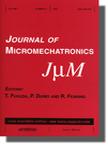版权所有:内蒙古大学图书馆 技术提供:维普资讯• 智图
内蒙古自治区呼和浩特市赛罕区大学西街235号 邮编: 010021

作者机构:Division Microrobotics and Control Engineering University of Oldenburg D-26111 Oldenburg Germany
出 版 物:《Journal of Micromechatronics》 (J. Micromechatron.)
年 卷 期:2006年第3卷第3期
页 面:267-284页
核心收录:
基 金:This paper is based on research work supported by the European Union (project ‘ROBOSEM’: GRD1-2001-41864) and the German Scientific Foundation (FA 347/6-1 FA 347&6-2)
主 题:Nanotechnology
摘 要:In this paper, current research work on an automated nanohandling station using mobile microrobots is presented. For the automated positioning of mobile microrobots a closed-loop control system is necessary, usually using data from pose sensors for the degrees of freedom (DOF) of the microrobot are needed. Mobile microrobots with piezo slip-stick actuation mostly do not have internal pose sensors to determine a global pose. This paper focuses on the continuous pose estimation (tracking) of mobile microrobots by external visual sensors. One possibility for fast pose estimation is the application of video cameras in combination with image processing algorithms as global sensors. However, for pose estimation with accuracy in the nanometer range high-resolution sensors are necessary. In consideration of resolution, image acquisition time and depth of focus a scanning electron microscope (SEM) is a powerful sensor for high-resolution pose estimation of a microrobot. On the other hand, the use of a SEM requires high demands on the image processing. High update rates of the pose data for the robot control require a short image acquisition time of the SEM images. As a result, the image noise increases as frame averaging or averaging of the detector signal is time consuming. This paper presents two approaches to tracking a micro-object in a SEM image stream. First, a cross-correlation algorithm is described, which enables pose estimation (x, y, Ψ) in extremely noised images in real-time. Afterwards object tracking with active contours is presented. This approach allows real-time tracking with more than 3 DOF by using shape spaces, instead of defining large model sets as it is necessary for correlation-based pattern matching. © VSP 2006.